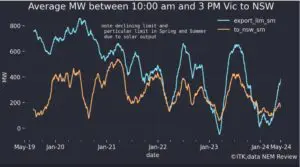Major changes are on the horizon for embedded network operators.
The Australian Energy Market Commission (AEMC) recently released draft changes to the network and retail exemption frameworks that currently regulate embedded networks in the National Electricity Market.
The draft changes go deep, proposing that exempt network service providers and exempt sellers will face obligations that closely mirror those required of distributers and retailers.
The proposed changes will likely see customers within embedded networks receive much needed protections, but also result in dramatic changes to the embedded network industry.
We have reviewed these changes, summarized them in this article and assessed the effects on the embedded network operators and others that benefit from the current exemption frameworks.
What’s up with embedded networks?
Today, businesses or individuals who supply or on-sellelectricity in an embedded or private network can do so under network or retail exemptions.
Holders of network and retail exemptions currently operate in a regulatory light environment, only needing to comply with a relatively small set of conditions that exist within the relevant exemption guidelines.
Penalties for breaches are limited and it has been difficult for the Australian Energy Regulator (AER) to police the sector.
With the explosion of embedded networks in the last 5 years, largely due to the boom in residential apartments in our cities, the AEMC now estimate over 250,000 customers live within embedded networks (we believe there are many more).
Many customers have unfortunately been subject to poor service, price gouging and difficulty in leaving embedded networks for better “on-market” retail offers.
To make matters worse, Power of Choice reforms introduced in December 2017 appear to have failed to deliver better outcomes for these customers.
Calls have been made by the public and COAG to review and improve upon the exemption frameworks.
Major changes proposed
The AEMC’s recent review is now proposing a wide-range of changes to regulations that govern the embedded networks industry. Key changes include:
New registration and exemption processes: Many exemptions classes will disappear, and two new market participant roles will be created. Exempt network service providers will now need to register as Embedded Network Service Provider (ENSPs) and retail exemption holders will need to be Authorised Off-market Retailers.
Market and system integration: all meters in new embedded networks will need to be registered with the market operator. This will allow all embedded network customers to be “discoverable” by retailers (i.e. in MSATS), removing a key barrier to competition.
Network billing: All new and existing embedded networks will be required to cap network charges at a level no greater than the amount that a customer would have paid had it been directly connected to the local distribution network.
Network regulation and connection: ENSPs will be required to provide customer connection services that mirror those of local distributors.
New consumer protections: Off-market Retailers will now need to meet similar compliance requirements to those of on-market retailers.
New monitoring and compliance requirements: Existing networks, new ENSPs and Off-market Retailers will be subject to a suite of new monitoring and compliance provisions. This includes the AER’s monitoring, investigation, and conduct powers, general information gathering powers and AER reporting requirements.
The rules will greatly affect new embedded networks, less so for existing
The bulk of the new rules will apply only to new embedded networks.
All embedded network operators who are expanding their operations will need to register as ENSPs and, as appropriate, become Authorized Off-market Retailers.
Impacts to legacy networks will likely be less but there will likely be new registration requirements for networks that previously operated under “deemed exemptions”, along with needing to comply with new network pricing, monitoring and compliance provisions.
Embedded Network Managers will have a diminishing role going forward. ENMs will still support legacy embedded networks but it is currently proposed they will have no role in new embedded networks under the new framework.
Solar PPA providers will still be able to apply for retail exemptions but will have a new requirement to register for network exemptions for each site they supply.
Grid-connected microgrid providers and other innovative businesses that previously hoped to operate in regulatory-light exemption frameworks will likely now have a whole new set of challenges they might not have bargained for.
It’s still unclear exactly how the changes will affect existing networks
At this point, the proposed changes to the AEMC are just draft, with the final rule changes being released at the end of May. The AEMC have forecast the charges will come into effect within 12-18 months from COAG endorsing the changes (we think that’s optimistic!).
A lot could evolve in this time, especially between the draft and the final rule change as the states look to legislate the changes.
It’s still very unclear the extent to which the rule changes will affect legacy networks. The AEMC explicitly asked for feedback on the draft changes for how to regulate legacy networks.
We will have to wait until May to more clarity here. It’s also still unclear how the ball will bounce in Victoria after they threatened to ban embedded networks.
Expect dramatic impacts to the embedded network industry
The changes are significant, well targeted and necessary.
These changes will harmonise customer protections for customers within embedded networks to those enjoyed by normal on-market customers.
However, the changes will certainly benefit the industry incumbents – mature embedded network operators, retailers and distributers alike.
Mature embedded network operators will likely take the changes in their stride, and perhaps even benefit from them due to reduced competition and clarity around interactions they currently have with retailers for on-market customers in their networks.
Loss of market share by retailers to embedded network operators will probably slow down for a few reasons.
1) consolidation of the embedded network market is likely to benefit retailers with a war chest of funds for acquisition,
2) retailers already operating as ENOs will face reduced competition and
3) retailers looking to churn off-market customers will face drastically reduced barriers in new embedded networks.
Proponents of smaller embedded networks will likely opt to connect to distributers reducing their loss of market share also.
In our view, embedded network operators who do not have proven ability to acquire customers, or the necessary skills, technical prowess and funds to comply with the proposed changes will likely be looking for the exits.Watch this space closely!
James Allston is the Managing Director of New Energy Ventures, a management consultancy that specialises in new energy projects and businesses. New Energy Ventures works extensively with embedded networks, helping property developers and energy companies to create profitable businesses by maximising the use of new energy and achieving good outcomes for end customers.










